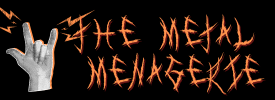History of Metal
The 1980s: Heavy Metal, Hair Metal, Glam Metal
"Heavy metal (or simply metal) is a genre of rock music that developed in the late 1960s and early 1970s, largely in the United Kingdom and United States. With roots in blues rock, psychedelic rock and acid rock, heavy metal bands developed a thick, monumental sound characterized by distorted guitars, extended guitar solos, emphatic beats and loudness." Read the rest of the article on Wikipedia
Metal continued changing and evolving after its earlier beginnings and in dialogue with the musical movements around it. In the 1980s, that meant the arrival of hair metal and glam metal, heavy metal fused with the aesthetics and musical stylings of earlier glam rock acts.
Headline acts like Kiss, Twisted Sister, Van Halen, and Def Leppard carried the genre through to the 1990s.
The 1990s: Grunge Metal, Alternative Metal, Speed Metal
With the arrival of grunge and the increasing appeal of metal to mainstream audiences, the subgenres multiplied and new bands continued pushing the limits of what metal could be. Alternative metal combined slower guitar riffs with harsh vocals, speed and thrash metal brought brutally face-paced songs and technical proficiency, and grunge metal added down-tempo drums and emotionally complex lyrics.
Headline acts like Alice in Chains, Faith No More, Metallica, and the Deftones carried the genre through to the 2000s.
The 2000s: NuMetal, Rap Metal, Industrial Metal
The arrival of a new millennium meant metal continued to evolve. Rap's increasing mainstream reach prompted an evolution in most forms of mainstream rock, and metal was no exception. The fusion produced numetal and rap metal, both of which also borrowed heavily from funk and hip hop musical stylings and often featured performers more known for their work in rap and hip hop. European influences brought industrial metal to American shores.
Headline acts like Korn, Slipknot, Limp Bizkit, and Rammstein carried the genre through to the 2010s.
The 2010s: Metalcore, Progressive Metal
"Metalcore is noted for its use of breakdowns, which are slow, intense passages conducive to moshing, while other defining instrumentation includes heavy and percussive pedal point guitar riffs and double bass drumming. Vocalists in the genre typically perform screaming; more popular bands often combine this with the use of standard singing, usually during the bridge or chorus of a song. However, the death growl is also a popular technique within the genre." Read the rest of the article on Wikipedia
Progressive metal grew out of a fusion of prog-rock and metal and would give rise to groove metal in the 2020s.
Headline acts like Opeth, Gojira, Bullet for My Valentine, Day to Remember, and Avenged Sevenfold carried the genre through to the 2020s.
The 2020s: Groove Metal
"Groove metal makes use of elements of thrash metal, but plays them in a slower tempo, making use of bouncy, unconventional rhythms. Loudwire stated that "Unlike so many other styles of metal, groove metal is one that doesn't have rigid boundaries and incorporates industrial, death metal, nu-metal, hardcore and a lot more." Music journalist Gary Graff also noted the influence of hardcore punk as integral to groove metal." Read the rest of the article on Wikipedia
Groove metal is currently enjoying the best of all possible worlds, blending traditional hardcore metal subgenres with external influences to produce something new and flexible enough to appeal to many tastes.
Headline acts like Gojira, Mastodon, Sleep Token, Intervals, Tool, and Animals as Leaders are the most recognizable current names still touring.

